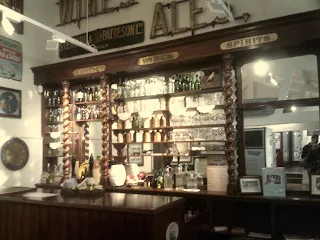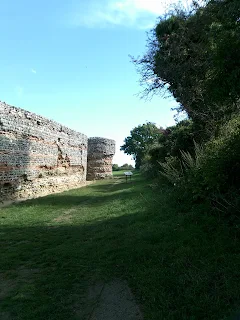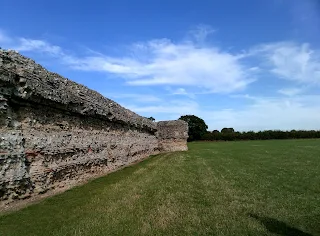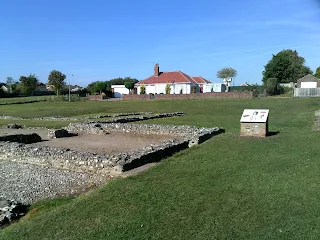Before we begin this blog we must start with a strange and obsessive tale...
I really should work as a researcher as I love checking out historical facts and am like a dog with a bone- once I get a whiff of a lead, I won't give up until I get an answer.
I really should work as a researcher as I love checking out historical facts and am like a dog with a bone- once I get a whiff of a lead, I won't give up until I get an answer.
I must cast my mind back to the summer of 1976 (I'm almost 100% sure of the year) when I would have been 5. We went on a day trip to Norwich by bus (I remember singing the nursery song: 'Fiddle-De-Dee, The Fly Has Married The Bumble Bee' all the way there) and ate upstairs at a fish and chip restaurant in Timber Hill. A bit of Googly nosey parkering has revealed that it was called Valori's (I told you I'm tenacious with my research) and I guzzled a bottle of Coca Cola.
This meant only one thing: and that is that I was desperate to go to the toilet a couple of hours down the line. The lack of public toilets available in the UK pisses (excuse the double entendre!) me off today, so imagine what it was like forty years ago, when shopping malls, which are usually well-serviced with such facilities, didn't exist.
This meant only one thing: and that is that I was desperate to go to the toilet a couple of hours down the line. The lack of public toilets available in the UK pisses (excuse the double entendre!) me off today, so imagine what it was like forty years ago, when shopping malls, which are usually well-serviced with such facilities, didn't exist.
Anyway, my mum took me down Bridewell Alleyway, pulled my drawers down, and I urinated in a shop doorway, only for the lady who ran this cake shop to come out and say (rather understandably) in her posh voice, 'Oh no, not in our doorway!' and then come back and swill the ground down with a bowl of water.
Me, being not right in the head, had to track down this doorway (I remembered the sloping, chequerboard, tiles) and take a photo of it.
And, just to make sure it was the correct shop doorway, I did more Googly research, and came up with some info about 1970s Bridewell Alley. I was indeed correct, and the shop was called 'Home Made Bakers' and the proprietors were D. & E.M. Vignaux.
I'm not normal, am I?😁
Back to the blog, and the Bridewell Museum started life, in 1325, as a rich merchant's house, before becoming a 'Bridewell' (a prison for women and beggars). From 1828 it served as a factory and warehouse for goods such as tobacco, leather, shoes and boots. It became a museum in 1925, displaying objects relating to local industry and people.
If you pop in an hour before closing, the entrance fee is only £1.50.
I did wonder about the significance of a gilded sheep hanging from the ceiling (it made me laugh!) and it would have hung outside a shop which imported eastern textiles.
I liked this sedan chair in the first cabinet you view. I didn't use a flash as my camera EATS batteries even without using one (note to self- get a better camera!)
Textile cabinet and a bit of reflection...
This dress dates back to 1873, and is a Norwich silk wedding dress.
This is the SuperDean's photo, and he said it would make a good dress for his Irish mother to wear whilst out celebrating St Patrick's Day!
A cabinet devoted to Valentine's Day gifts. The preceding day, February 13th, must have been very busy and profitable for local retailers and merchants!
Historical shop...
Colman's produced mustard here in Norwich, and there used to be a lovely, cute museum (sadly now closed) down the Royal Arcade, devoted to it.
Vain Old Tart (not looking her best...)
Apothecary. Looking at some of the medical objects and 'cures', let's just say that I'm glad I live in this day and age...
This machine makes wire netting...
I briefly worked in a chocolate factory, when I was 16, and operated a machine exactly the same as this. The factory called it a 'One Shot' (I have absolutely no idea why) and it coats the fillings with chocolate.
Another job of mine (fashion designer) is represented by this jacquard weaving loom...
And then we come to the shoe cabinets...
Shoe manufacturing is described and I got serious shoe envy looking at these...
Want...
Sparkly beauties...
I had a pair of mule slippers like these as a kid!
My favourites- I loved their crinkly front...
But, the following week I found my own crinkly fronted shoes for £3.50 in a charity shop in Great Yarmouth. My friends think they're better than the museum piece!😃😃
The museum is not just about industry and some household items feature. There are more display cabinets to see, but not all of my pictures were good enough to post.
The bar...
...And a Vain Old Tart...
Mock-up of a 1950s living room...
I'll finish with this cute chap. The canary is the mascot for Norwich City Football Club...
After this, I visited Head In The Clouds, a new age/ ethnic/ alternative clothing and lifestyle shop. I remember popping in as a young teenager. It advertises itself as 'Britain's oldest headshop' and has been here since 1971. Peace and love, man!
I bought this lovely, colourful scarf...
I thought I'd conclude this blog with photographs taken from my visit to Norwich Castle, a day later, as I really didn't take enough pictures for it to warrant a post of its own. It is a medieval Norman castle, founded when William the Conqueror (r.1066-1087) wanted a fortified place in the town of Norwich.
He wasn't responsible for the lift, though...😉
The castle has been repaired repeatedly, with its outer Bath stone shell dating from 1835-9.
The museum and art gallery hold significant collections from nature and art in the area.
Here is the view of the modern section. The galleries snake off from a central rotunda.
There were way too many artefacts for me to photograph (we would have been there all day), so I honed in on the few pieces that really appealed to me.
There was a wonderful Rene Magritte (1898-1967) small exhibition that I chose to absorb, rather than see through a lens. It was about a lost painting, discovered, in sections, underneath other paintings
Here is a PDF of La Pose Enchantee (The Enchanted Pose), 1927.
This is 'The Largest Teapot In The World' and was made for the Great Exhibition in Hyde Park in 1851. It's probably Staffordshire pottery, and holds 60.75 litres of liquid.
This figurine is a Seated Nude by Philip Eglin. It is covered with newsprint depicting the Hugh Grant and Divine Brown scandal of 1996.
These are by Ana Maria Pacheco (b.1943) and are entitled Man and His Sheep I and Man and His Sheep II. They date from 1986 and are about the relationship between the group and the individual. I 'get' this work and often think that people are stupid and behave like sheep.
The castle was actually a bit of a let down- we wanted to visit the keep (which was probably built between 1095 and 1110) but the lower section is currently closed for restoration and won't open again until 2020. Oh well, here is the main floor...
Lavatorial moi just had to take photos of the garderobes...
...And the modern day khazis. These sinks in the ladies' loos were painted with shoes. How lovely is that?!😄
We must finish this blog with another strange anecdote...
The first time I visited Norwich Castle was on a school trip, and I was 12. Me and my best friend decided to nick sweets from the castle shop, but two busybody, tell-tale-tit boys in our class decided to tell our teacher. This resulted in detentions all round (no police involvement- I think, if they knew, they would have been keen to pass on that one.)
The fallout, though, was IMMENSE. My partner in crime and another 'friend' (you know who you are, Miss Wonky Gob and Miss Religious Nut) decided to turn their backs on me and encouraged others to do the same. Well, I just went off and found newer, truer, friends. I also have issues with my headteacher, as I'm pretty damn sure he convinced my partner in crime to keep away from me, even though she was the instigator.
All three of you are horrible people, and are going to get VILIFIED in my next novel.
On cheerier note, though, my parents didn't take it too seriously. My mum said, 'When the headteacher rang to tell me you'd been stealing from Norwich Castle, we expected to come home and find a suit of armour in the hallway!'
Hahahahahahahahahaha!!!!
So I'll leave you with a photo of this chap. He stands and guards the entrance desk.
TTFN
The Miss Elaineous
XXXXXXXXXXXXXXXXXXXXXXXXXXX
XXXXXXXXXXXX
XXXX
X











































































